Glue Plastic
Strong PLASTIC GLUE & Plastic adhesive
If you are looking to glue plastic, both Adiseal adhesive and Adiglue are strong glue for plastic. Adiseal adhesive provides a strong, waterproof, durable and flexible bond on many different plastics.
There are many different types of plastics including PVC, ABS, polycarbonate, Plexiglas, perspex, acrylic, polyethylene, polypropylene & polystyrene to name a few. Adiglue will provide strong bonds on a variety of plastic as well as other materials.
- What is the best adhesive for plastic?
- What is the best glue on plastic?
- How to glue plastic
- Plastics that are hard to bond
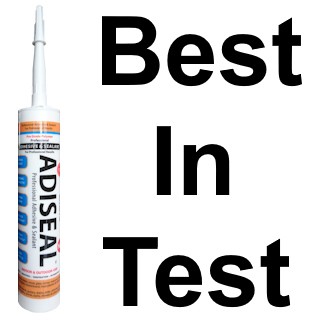
What is the best adhesive for plastic?
Is it possible to glue plastic using an adhesive? The answer is yes, if using the record breaking strongest Adiseal adhesive sealant.
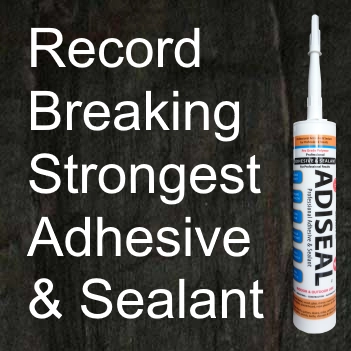
Why Adiseal is the best adhesive for plastic
Adiseal adhesive sealant has been shown to be the strongest adhesive in an independent adhesive strength test by Ultimate Handyman.
Strongest adhesive strength test results table
| Product | Max pressure when adhesive bond broke (psi) |
| Adiseal | 3123 + psi |
| SupaBond | 1115 psi |
| Tec 7 | 1016 psi |
| HB42 | 942 psi |
| Loctite PL Premium | 873 psi |
| Gorilla Grab Adhesive | 862 psi |
| Bond It PU18 | 582 psi |
| Bond It Save Nails | 411 psi |
“That is actually unbelievable!”
Testimonials
Testimonials & some comments on the: Grab adhesive tests 2017, video on YouTube
- That Adiseal is phenomenal!
- That Adiseal is some stuff though, definitely need to get some of that bought!
- I instantly went looking for Adiseal!
- Need to get my hands on some of that to try out.
- Looks like a cracking product.
- Having used the two most expensive brands on numerous occasions, I’ll be trying out the others, especially the Adiseal.
- Adiseal certainly surprised me in this test!
- Fantastic tests. It’s unbelievable that Adiseal test with the hardwood.
Benefits
Some of the other reasons why Adiseal is the best product when trying to glue plastic:
- Adiseal stays permanently flexible so it will absorb any vibration and allow any items to expand and contract without the adhesive becoming weak.
- It’s a waterproof sealant and waterproof glue for plastic so it is also suitable for use outdoors or indoors. It works in dry, wet & even underwater.
- Has very high gap fill properties.
- Has high initial grab meaning temporary supports may not be required while the adhesive cures. Adiseal Hi-Grab has even higher grab than the standard product.
Waterproof glue for plastic
Adiseal is a waterproof adhesive suitable for bonding plastic in wet or underwater conditions. It can also seal leaks instantly, even underwater. In our demonstration below, we cut a 1cm x 25cm hole in a plastic tub then filled the tub with water. With the water pouring through the hole, Adiseal was used to seal it instantly, stopping the leak in an instant.
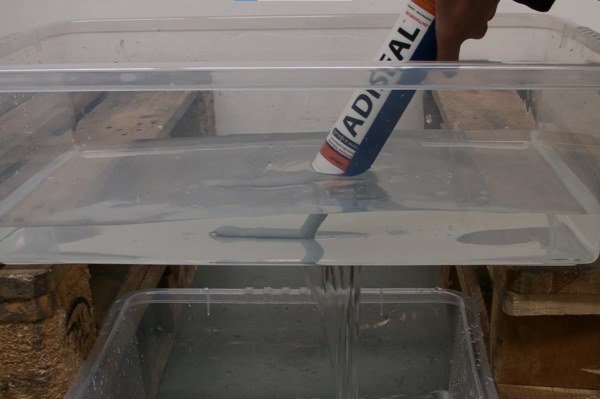
Video of applying Adiseal waterproof adhesive and sealant to seal leaks on plastic.
Adiseal will stick plastic to the following items
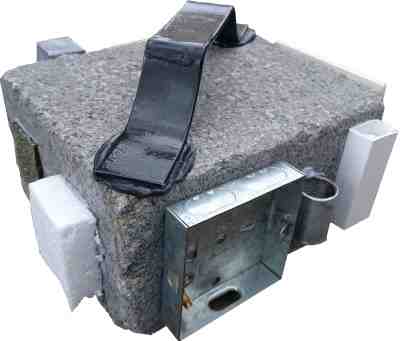
What is the best glue on plastic?
Adiglue is our best glue on plastic. It’s a high-performance industrial strength glue that outperforms other products and super glues. Adiglue provides a stronger and less brittle bond than super glues.
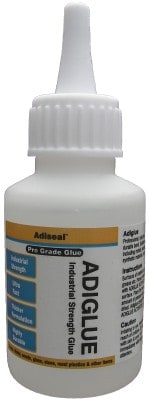
How is Adiglue better than super glue?
Adiglue is a superior glue compared to standard super glues. This is due to its almost 100% pure cyanoacrylate composition, in contrast to super glues that contain solvents for cost-effective manufacturing. These solvents cause typical super glues to dry very quickly but result in weak and brittle bonds.
Additionally, Adiglue’s formulation allows it to remain usable for up to 18 months, even with the bottle open, as long as the nozzle is kept clean and the bottle is stored upright. Unlike traditional super glues, Adiglue dries quickly but slightly slower, resulting in a much stronger and less brittle bond.
Super glue gel
Adiglue’s thick gel formulation allows for higher gap filling, making it suitable for applications where standard super glues might not suffice. Moreover, its thicker consistency enables easier and less messy application compared to other glues.
Clear glue
Adiglue is a completely clear glue and stays clear once it has cured. This is very useful when a clear glue is required like a clear glue for clear plastic.
Glue strength demonstration
We showcased Adiglue’s exceptional strength by bonding MDF wood blocks together and even adhering house bricks to both the MDF and other bricks. Achieving this level of bonding isn’t feasible with other conventional glues.
Adiglue will bond plastic to the following items
Adiglue will successfully stick plastic to the following items:
- Wood (porous wood like MDF require sealing first with Adiglue Activator)
- Glass
- Stone (porous stone requires sealing first with Adiglue Activator)
- Ceramic
- Rubber
- Metal
- Synthetic Materials
- Leather
- Plastic
- Concrete (once sealed with Adiglue Activator)
- Brick
- Masonry
- Marble
- Granite
- Mirror
- Many other items
Porous materials will require sealing first with Adiglue Activator. This will stop the material soaking up the liquid glue.
How strong is Adiglue
Adiglue is one of the strongest glue available. The strength of Adiglue will depend on the materials it is being used to bond. On some items, the strength of Adiglue is actually stronger than the material itself.
Adiglue strength example
In the example shown below, we sealed the edges of MDF wood blocks using Adiglue Activator, then applied Adiglue to bond the two blocks together. Once the glue dried, we conducted a strength test by attempting to break the bond by stamping on it.
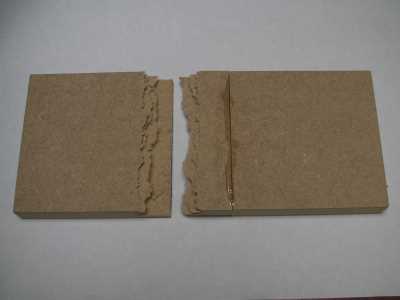
As seen in the image above, the MDF wood has broken before the Adiglue showing the glue is stronger than the MDF wood.
How to glue plastic
Glue for hard plastic
Adiglue is our best glue to stick plastic where the surface area is small. For items with a larger surface area, the Adiseal adhesive & sealant is the best product to stick plastic.
How to glue plastic
- Choose correct glue
There are lots of different types of plastics. Some glues perform better on certain plastics compared to others. Polypropylene and polyethylene can be difficult to bond and require special products.
- Clean surface
Make sure both surfaces are thoroughly clean to get the strongest bond. Clean the plastic surfaces to be glued with isopropyl alcohol or a similar solvent to remove dirt, grease, and oils. Roughening the surface with a gentle sandpaper can also improve adhesion.
- Apply glue
Apply the glue to one surface. Covering as much surface area as possible will provide a better bond.
- Push materials together
Push the materials firmly together. Remove any excess glue.
- Temporary supports
If the glue takes time to cure, temporary supports may be required to hold the items in place until the glue fully cures.
Tip: To store Adiseal once opened, leave about 1cm worth of product out of the nozzle and store the tube upright in a cool dry place. The exposed part out of the nozzle will cure creating a cap. To re-use Adiseal, pull the cured part out or cut the nozzle until the uncured part is reached.
Adiglue to glue hard plastic
To use Adiglue glue for hard plastic, make sure both surfaces are thoroughly clean to get the strongest bond. Adisolve is the ideal product to remove oil, grease, tar and other stubborn deposits.
Simply apply the glue to hard plastic and hold the items together until the glue starts to dry. Adiglue Activator can be used as a glue accelerator to quickly reduce the time it takes for the glue to cure.
Using Adiseal adhesive & sealant to stick hard plastic
To bond hard plastic using Adiseal adhesive, ensure that both surfaces are thoroughly cleaned for a strong bond, and you can use Adisolve to remove stubborn deposits. Apply the adhesive to one surface and firmly press the two items together. While Adiseal has high initial grab, you may need clamps to hold the items in place until the adhesive cures.
Glue for plastic to metal
To glue plastic to metal, both our Adiglue glue and Adiseal adhesive sealant will provide a good strong bond. Adiglue is our best glue to stick plastic to metal where the surface area is small. For items with a larger surface area, the Adiseal adhesive and sealant is our best adhesive to stick metal to plastic.
Using Adiglue to glue plastic to metal
For the strongest bond using Adiglue to glue plastic to metal, ensure both surfaces are thoroughly clean and free of rust by using Adisolve to remove stubborn deposits. Apply the glue to either the plastic or metal, and hold the items together until the glue starts to dry. You can also use Adiglue Activator as an accelerator to speed up the drying time.
Using Adiseal adhesive & sealant to bond plastic to metal
To bond plastic to metal effectively using Adiseal adhesive, ensure both surfaces are meticulously cleaned to achieve the strongest bond, and use Adisolve to remove oil, grease, tar, and stubborn deposits. Apply the adhesive to one item and firmly press the two items together, considering the need for temporary supports while the adhesive dries. It’s recommended to wipe away any excess uncured Adiseal with a thick cloth, and Adisolve can also be used to help remove any uncured adhesive.
Glue for plastic to wood
Adiglue is our best glue to stick plastic to wood where the surface area is small. For items with a larger surface area, the Adiseal adhesive & sealant is our best adhesive to bond plastic to wood.
Using Adiglue to glue plastic to wood
For bonding plastic to wood using Adiglue glue, ensure both surfaces are thoroughly cleaned to achieve the strongest bond, and use Adisolve to remove oil, grease, tar, and other stubborn deposits. In the case of porous wood, sealing the material with Adiglue Activator is necessary before applying the glue to prevent the porous surface from soaking up the adhesive. Apply the glue to either the plastic or wood and hold the items together until the glue starts to dry, and consider using Adiglue Activator as an accelerator to expedite the curing time.
Using Adiseal adhesive & sealant to stick plastic to wood
To use Adiseal adhesive for bonding plastic to wood, ensure both surfaces are thoroughly cleaned for a strong bond and use Adisolve to remove oil, grease, tar, and other stubborn deposits. After cleaning the surfaces where the adhesive will be applied, apply the adhesive to one item and firmly press the two items together. While Adiseal has high initial grab, you may need temporary clamps to hold the items in place until the adhesive cures.
Plastics that are hard to bond
Some plastics like polyethylene, polyurethane and polypropylene can be difficult to bond. This is because of the surface energy of the material. To be able to glue these plastics, the surface has to be treated first to change the surface energy of the plastic.
Colours
Adiseal adhesive and sealant is available in the following colours:
- White adhesive and white sealant
- Black adhesive and black sealant
- Grey adhesive and grey sealant
- Clear adhesive and clear sealant
- Brown adhesive and brown sealant
Adiseal can also be manufactured in any RAL colour.
Please note Adiseal adhesive sealant colours provides a stronger bond on plastic and other materials compared to the clear version.
Glue plastic vs mechanical fixings
It is possible to attach plastic with either glue or mechanical fixings. Either option has advantages and disadvantages. One disadvantage to using glues to bond plastic is they can be more difficult to remove when the bond is no longer required. A disadvantage to using mechanical fixing like screws is they will leave a permanent hole in the material. The screw might also stay visible and ruin the look of the plastic.
Sometimes both mechanical fixing can be used together with an adhesive or glue to make the plastic joint even stronger. Adiseal Ultimate metal drill bit is a great product to drill plastic. Adiseal Ultimate masonry multi-material drill bit will also drill plastic but the metal bit will drill cleaner holes.
Where to buy
In the UK, to buy glue for plastic from Adiseal stockists, contact us for more details. For other countries visit www.guglue.com
Frequently asked questions about glue for plastic
Adiglue is our best glue for plastic where the surface area is small. For items with larger surface areas the Adiseal adhesive and sealant is the best product to use.
The strength of glue on plastic will depend on the type of plastic being stuck. There are many different types of plastics including PVC, ABS, polycarbonate, Plexiglas, perspex, acrylic, polyethylene, polystyrene and many others.
Adiseal adhesive and sealant is the best waterproof product to glue plastic. It works in the dry, damp, wet and even underwater. It seals instantly even if there is water pouring.
Removing glued plastic parts can be difficult, and it may damage the materials. You can try using solvents or heat to soften the adhesive, but it’s best to avoid mistakes in the first place.
It depends on the adhesive used. Some adhesives provide water and chemical resistance, while others may not. Check the adhesive specifications for this information.
